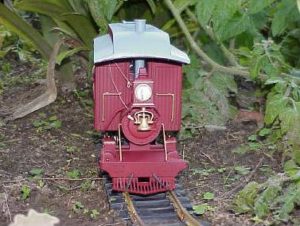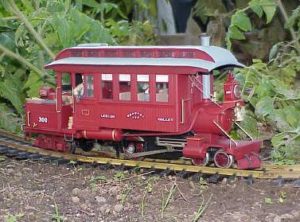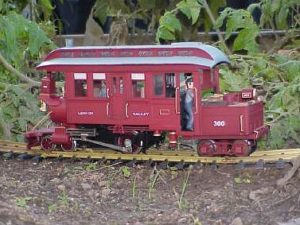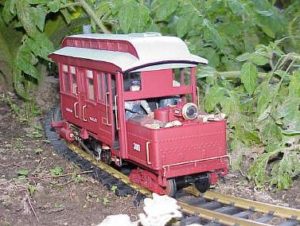Kitbashing Number 300 in “G” Scale
I first laid eyes on Dorothy when I was at the Los Angeles Live Steamers Annual Spring Steam-up in May 2000. I was at a vendor booth when I looked down at the table and there she was on the cover of a book of matches. As soon as I saw her I said to myself, she would make a nice addition to my model collection. I purchased the matchbook for fifty cents and I was on my way.
A little background, and I do mean little, because the only information I could find on her was on the back of the matchbook and off the web. Dorothy was a Lehigh Valley Inspection engine built at the Wilkes-Barre shops in May of 1884. She was designed by Alexander Mitchell and used to haul the Superintendent and other officials over the road. She was kept in active service until 1934 and then sold to Mr. John B. Vaughan of Kingston, Pa.




I used three different models to build her, a Baldwin 2-4-2 engine, a wood tender and a passenger coach. All three pieces were manufactured by Bachmann.
I started with the engine by unscrewing the body from the frame. Using my Dremel tool, I then made a cut just forward of the cabs front windows and another right behind the smokestack. The engine’s wheel alignment was then changed from 2-4-2 to 4-2-4. Removing the trailing pilot wheels and placing them right behind the front set did this. These wheels are also used to carry track power to the motor, so I made the necessary electrical connections. The wheels were secured to the frame by a screw and some crazy glue. I then cut one of the drive wheels off and removed the axle. This was difficult since I did not want to damage the gears inside the motor block.
The passenger coach was the Dremel tool’s next victim. My uncle, who was a carpenter, told me “measure twice, cut once,” so I measured the gap between the cab and the smokestack – you guessed it – twice. I used that measurement to make the cut on the passenger coach.
The cab and coach were then glued together. The seam was filled using Squadron putty and sanded when dry. The original roof of the coach was too long so two cuts were made to remove the middle section. The two ends were then glued and filled. I did not worry about this seam being to smooth because the roof would be covered with masking tape.
A two-truck tender was cut in half and glued to the back of the cab. The whole unit was then sprayed Boyd Red of Colors by Boyd and set aside to dry. I followed up by drilling a hole in the roof above the smoke box for the installation of the smokestack. A roof hatch was also added above the cab for those really hot days. Strips of masking tape painted gray were laid on the roof to show roofing material. Woodland Scenics numbering & lettering was then applied. To seal everything, a spray of Testors Dullcoat was used.
Next the whistle, bell, and an operating headlamp were added. The coach has five seats and interior lighting. Seated inside are three Aristo-Craft figures that are now superintendents of the Lehigh Valley Railroad. They are patiently waiting while the engineer and fireman, which are made by Bachmann, build up enough steam to get under way. They all expect a long day of riding the rails.
Right from the start I knew this would be a fun project, but it took longer than expected – a few hours a night for about three weeks. If anyone has any information on Dorothy 300 please email me (richie dot scanapico at attws dot com) – I would really appreciate it.
I would also like to thank Red Payne for his time and equipment in taking these photos.